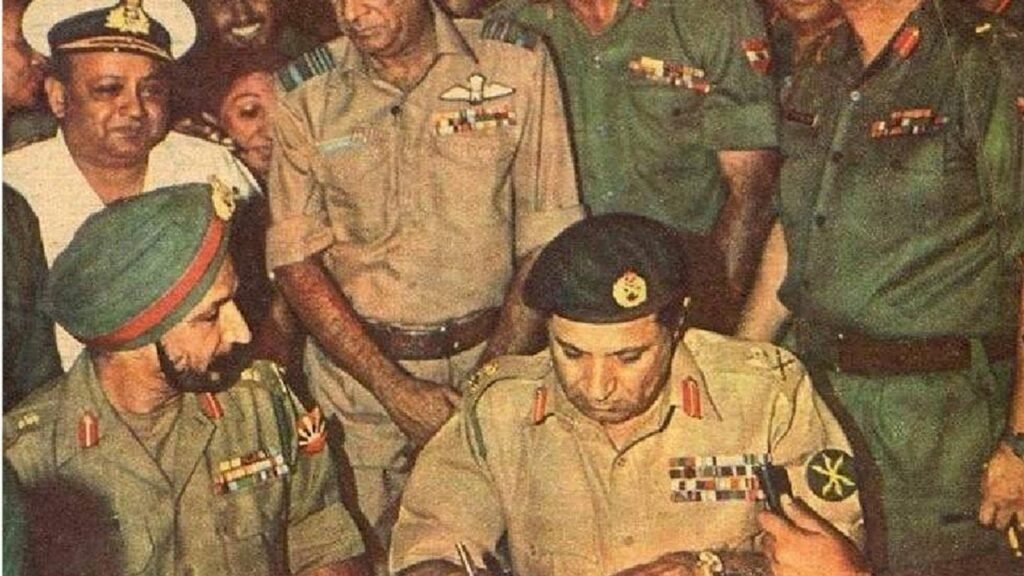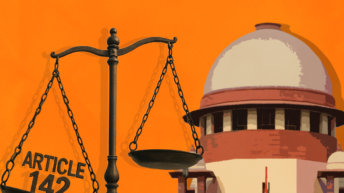
The War
It had taken just under a fortnight to vanquish the Pakistani military which saw the surrender of 93,000 of its soldiers. The Liberation War of 1971 had officially begun soon after the Pakistan Air Force carried out a preemptive raid on Indian air bases on the evening of 3 December, but the Mukti Bahini had been active for the past many months inside East Pakistan, harassing and attacking the Pakistani security forces, forcing them to cover their flanks and rear and allowing them no rest or respite. Eastern Command had initially set up eight training camps for the Mukti Bahini and these were later increased to eleven, of which one camp was purely for officers. The Indian army had been accorded approval to attack Pakistani positions within 10 miles of the border and these attacks had commenced by end October. Fierce battles were fought in Dhalai, Atgram, Garibpur, Shamshernagar and Hilli amongst others. On 21 November, two Pakistani F-86 Sabre jets were shot down by Indian MiG 21 Fighters when they intruded into air space and their pilots were taken prisoner, marking the first aerial combat between India and Pakistan since the 1965 war.
With the official outbreak of war, the Indian Army went on an offensive on four thrust lines. From the West, the newly raised IInd Corps under General Raina made a thrust towards Jessore. In the North-Western sector, XXXIIIrd Corps under General Thapan moved along the Hilli-Gaibanda axis to cut the area into two. In the North-Eastern sector, 101 Communication Zone moved along the Jamalpur-Tangail axis towards Dhaka and in the South-Eastern Sector, IVth Corps under the indomitable General Sagat Singh was tasked to contain Sylhet and then move to capture Chittagong.
The main offensive commencing in the early hours of 4 December went as planned, with the Indian forces bypassing cities and moving swiftly towards their objectives. It was however left to the genius of General Sagat Singh to bring the Pakistani forces to their knees. Sensing an opportunity, he used the helicopters under his command, to make a brilliant crossing of the Meghna River, which altered the course of the war. The para drop of 2nd Parachute Battalion at Tangail on 11 December was the Indian Army’s first airborne assault and it shook the military leadership of the Pakistanis. The battalion thereafter, laid an ambush at Poongli bridge and cut off the Pakistani forces retreating from Jamalpur, inflicting heavy losses on them. 1st Maratha of 95th Brigade linked up with this force the next day.
On 14 December, the IAF carried out a precision attack on the Governor’s house in Dhaka, just at the moment when the Governor was holding a high level meeting. The Governor in a panic resigned and thereafter took shelter in the Intercontinental Hotel, which had been declared a peace zone by the UN. That was the end of the government. That evening, Lieutenant General Niazi and Major General Farman Ali, who was a senior military advisor to the government, went to see the American Consul General, Mr Spivack, with a ceasefire proposal which broadly entailed a ceasefire under UN supervision, handover of the government to UN, withdrawal under UN monitoring, no trials and no mention of India. This of course was rejected by India.
By the evening of December 15, the noose had further tightened around Dhaka. 95th Brigade was at the Mirpur Bridge over the Bhuriganga River and early next morning was at Kurmitola. IVth Corps was also knocking at the gates of Dhaka, with the 311th Brigade close to area of Gulshan Model Town next to Dhaka Cantonment and 301st Brigade in the area of Adamji Jute Mills in Narayanganj. The Pakistani Army in Dhaka was now hemmed in.
The Surrender
From the early part of the morning of 16 December, the atmosphere all across the war zone in East Pakistan was electric, in anticipation of the surrender of the Pakistani Armed Forces. A ceasefire had come into effect by midday and at 2 pm, the Army Commander, Lt Gen JS Aurora along with Air Marshal HC Dewan of Eastern Air Command and Vice Admiral Krishnan of the Eastern Fleet landed at the Agartala airfield. They were received by GOC IVth Corps, Lt Gen Sagat Singh and thereafter, the group accompanied by a bevy of reporters moved in ten helicopters—five Alouettes and five MI 4—to Dhaka airfield.
Earlier in the day, Maj Gen JFR Jacob, the Chief of Staff, Eastern Command, had met Lt Gen Niazi at his headquarters and given him the terms of surrender. The meeting had been arranged by Maj Gen Nagra, the commander of Eastern Command’s 101st Communication Zone Force. He had contacted Gen Niazi a day earlier and also met him in the morning of the 16th. His two brigades, 95th and 167th Mountain Brigades, had moved up to the Dhaka cantonment and this force had been further strengthened by a squadron of PT 76 tanks. The tanks had been moved forward by General Sagat Singh as an additional precaution, to ensure enough physical evidence of the military strength of the Indian forces in Dhaka.
The helicopters with the Indian commanders and a bevy of reporters landed at Dhaka airfield and were received by their Pakistani counterparts—Lt Gen AAK Niazi, Rear Admiral Mohammad Shariff and Air Commodore Inamul Haq. The victors and the vanquished then drove to the Ramna Racecourse, five kms from the Tezgaon Airfield. for the surrender ceremony. Bangladeshi flags fluttered atop all the rooftops and the streets swarmed with millions of people waving flags and cheering to the cries of ‘Joi Bangla’.
A table and two chairs had been procured from Gen Niazi’s office. General Aurora was given a Guard of Honour by a hurriedly arranged mix of available Pakistani troops, with Gen Niazi’s ADC, commanding the motley contingent. The two commanders sat down and the surrender document was placed before Niazi. He read the same and then signed all the five copies. General Aurora then signed the documents. He asked Niazi for his pistol and the same was handed over. Then General Niazi’s badges of rank were removed which marked the end of the surrender proceedings. The crowd in the Ramna ground was delirious with joy. Dhaka was now the free capital of a free country.
The Rescue
While the Pakistani forces had surrendered, the family of Sheikh Mujibur Rahman was still under the custody of the Pakistani forces. At nine in the morning of 17 December, Maj Ashok Tara of 14th Guards was summoned by his Commanding Officer Lieutenant Colonel VN Channa. He was told that Sheikh Mujibur Rahman’s family was under house arrest and that his wife and children were being guarded by a contingent of Pakistani troops. “Your job”, the CO told Maj Tara, “is to get them back safely”.
Moving quickly to the area with his troops, Maj Tara found the house guarded by trigger happy sentries who were blissfully unaware of the surrender that had taken place a day earlier. A direct assault could have caused bloodshed inside the house, so Maj Tara walked up to the gate alone and unarmed. The sentry had his finger on the trigger but he held his fire. Over the next half an hour or so, Maj Tara convinced the captors to surrender their arms and a great deal of bloodshed was avoided. Most importantly, Mrs Mujibur Rahman and her daughters Hasina and Rehana, along with some other relatives were safely rescued. That was indeed most fortunate as Sheikh Hasina is now the Prime Minister of Bangladesh.
Post Script
The valour of the Indian Armed Forces has never been in doubt, but an account by Sydney Schanberg, the Pulitzer winning American journalist as published by the New York Times post the Liberation War is a great tribute to the Army. This is what he wrote:
“I don’t like sitting around praising armies. I don’t like armies because armies mean wars. But this (Indian) army was something. They were great all the way. There never was a black mark…I lived with the officers and I walked, rode with the jawans-and they were all great. Sure, some of them were scared at first-they wouldn’t be human if they weren’t. But I never saw a man flinch because he was scared. There was tremendous spirit in the Indian Army and it did one good to experience it. I have seen our boys in Vietnam-and this army was different. Their arms and equipment aren’t as good-but what they had was used with effect and boy! could they improvise. I saw heavy recoilless guns carried on shoulders, big guns pushed across marshes like ox-carts, by jawans, villagers, officers, everybody was in it together and they were perfect gentlemen. I never saw them do a thing wrong not even when they saw just how bestial the enemy had been.”





An unparalleled victory achieved by the Indian Armed Forces. Magnanimity in victory towards the vanquished is what makes a great Army.
A very informative article. It presents a comprehensive account of the build up to war, and the thrust-lines of the Indian Army. The US decision to send Task Force 74 of their Seventh Fleet, with the nuclear-powered aircraft carrier USS Enterprise, impacted the USSR decision to lay down a timeline for applying a veto; thereby necessitating an increase in the rate of advance. The pace of operations effectively increased.
This article is a commendable tribute to the valour, leadership and strategic acumen of the Indian Army. Thank you very much, Gen Katoch.
1971 war demonstrated the whole-of-a-government approach to win it. Salute to Indian Armed forces ably supported by fearless Mukti Bahini.
What we won in war we lost it on table? Major lesson of war was need for sharper strategic vision.
A concise write up of operations in the East during the 71 War and in h he surrender.It was the first time after WW2 that a new nation was created any where which the force of arms. The key to the rapid termination of hostilities was the actions of 4 Corps.
Sydney Shanberg
Thapar77@hotmail